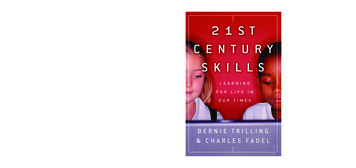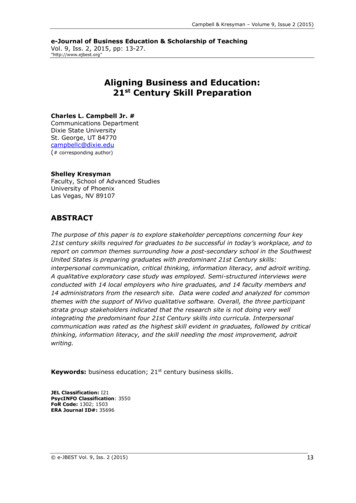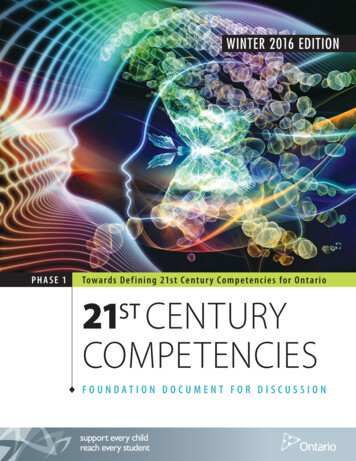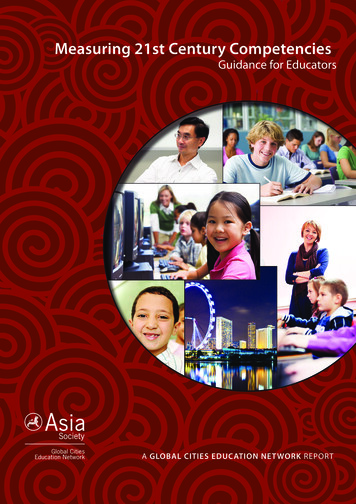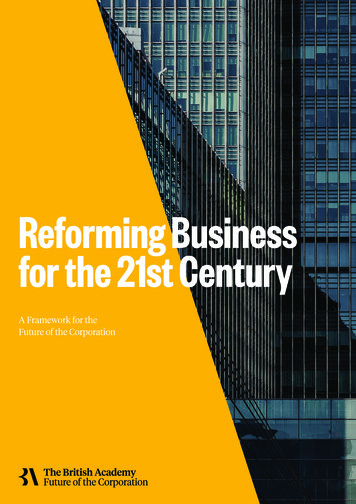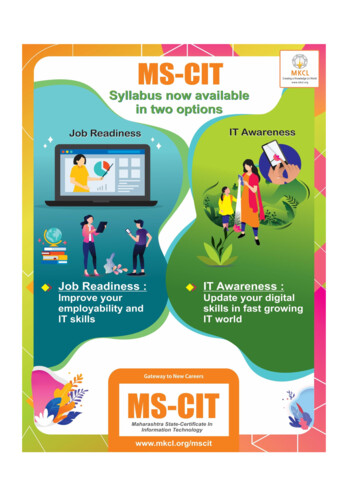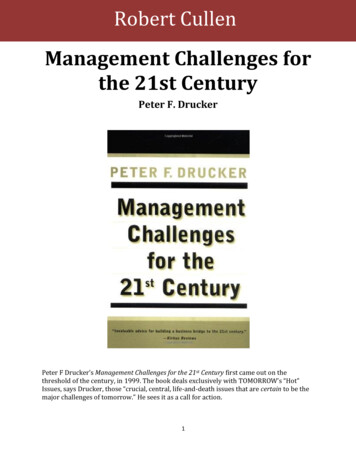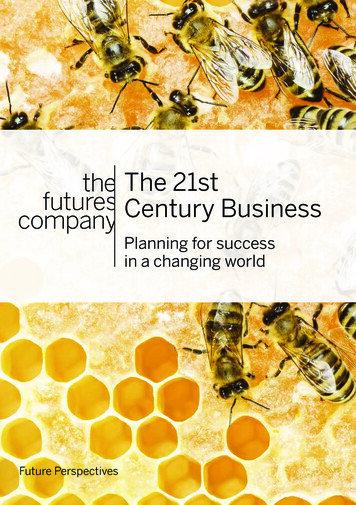
Transcription
The 21stCentury BusinessPlanning for successin a changing worldFuture Perspectives1The 21st Century Business
Future Perspectivesare thought pieces withconcise, focused insightsinto important issuesof interest to marketingand business strategists.For more information please visitwww.thefuturescompany.comThe 21stCentury BusinessThe corporation is at a crossroads.The businesses that we have grownup with and the business models thatunderpin them face deep challenges.They are being reconstructed, fromwithin and without, by pervasivetechnology. Their values, and thevalues associated with work and theworkplace, are increasingly beingquestioned. Their model of resourceuse, of “use it and throw it out,” isincreasingly running up againstconstraints of supply costs.New ways of designing and managingbusinesses, and new businessmodels, are inevitable. 2014 The Futures Company. Some rights reserved.2
The list goes on. Corporatebehavior towards society,including their customersand employees, isincreasingly under scrutiny.The financial crisis hassharpened the idea thatunethical and unsustainablebehavior is an external costthat should not be paid forby the public, and that ifcompanies draw on publicIn short, the assumptions thatgoverned the mass-productionbusinesses of the 20th century,and were codified by managers,researchers and academics inthe '50s and '60s, have run outof gas. They are no longer fitfor purpose.services, such as roads andeducation, they also shouldmake a fair contribution.world there are examples ofcompanies that have startedto absorb the lessons of the21st century and have startedto adapt. They are innovatingOur leading businesses alreadyunderstand this and are actingon it. Across the business3their business models, theircorporate systems, and theirorganizational hierarchies.The sense that change is in theair is amplified by the numberof business initiatives thathave been sparked recently.By way of illustration, oneinfluential CEO, Paul Polman,at Unilever, is engaged withfour such initiatives: theInclusive Capitalism Taskforce,the Sustainable EconomyProject,1 the B Team and the“We Mean Business” coalition.2The 21st Century Business
The changes outlined in thisFuture Perspective representa significant disruption tothe way most businessesoperate today. Some maystill believe that, eventually,we will return to a pre-crisisworld. This seems unlikely.As we discussed in our FuturePerspective Technology2020, financial crises aretypically associated witha deep transformation ininfrastructure and technology.They mark the start of a longtransition in how society thinksabout itself. We’re still at anearly stage in that journey, butbusinesses that do not adaptare unlikely to survive in themedium-to-long term. In otherwords, however great the costsof change, the costs of notchanging will be higher.The challenges run deep.In this Future Perspective,we first outline eight macroforces that are reshaping the21st century corporation.We then examine thelandscape of the businessjourney to sustainability andbeyond. Next, we analyze thesix pillars that will frame the21st century organization,finishing with a discussion ofhow to start on this journeytowards the future.In summary, the whole storycan be wrapped into threeguiding principles: Organizational cultureis more importantthan strategy Intrinsic values arebecoming moreimportant than extrinsicvalues, for both customersand employees Connection is the keyto both driving downcost and driving upcustomer engagement 2014 The Futures Company. Some rights reserved.4The business models thatwere developed in the 20thcentury emerged in a world ofabundance, but the businessmodels of the 21st century willhave to contend with scarcity.If the business world of the20th century was that of thelimitless, open range, that ofthe 21st century is more likean ark—cramped, delicateand confined.3
Snapshot of the 21st Century BusinessThe 21st century business is being reshaped by a combination of resourcepressures, shifting social values and ubiquitous technology.The businesses that win will have redesigned themselves.Betternetworked,more open,more fluidBecause it’sthe best way toserve customersin the newbusiness world.Shifted from“creating wants”to “fulfillingneeds”Createdhigh trustworkplacesTo build longterm customervalue andsustainablerelationships.The benefitsof trust aremeasurable, andgo straight tothe bottom line.What to doDo you understand.The wholecontext inwhich yourcustomersare using yourproducts andservices?The wholelife cycleof yourproducts andservices?What leadingedge brandsand customersare doing inyour sector?How widertrends areshaping theexpectationsof yourpeople?Source: The Futures Company5The 21st Century Business
The eight macro-forcesshaping the organizationIn our Future PerspectiveThe World in 2020, we reviewedsome of the macro-forces thatwere creating this squeeze onspace and resources, and haverevisited and updated thembriefly here:41Population: The worldpopulation has passedseven billion and isexpected to reach eight billionby 2030. Most of those newpeople will be born in Asia andwe expect to see the rapidgrowth of mid-size cities onthe continent.5 But populationand resource consumptionneed not be directly related.3Food: The trendsshaping foodconsumption arebroadly negative on both thedemand side and the supplyside. On the supply side, thenumber of hectares per headavailable for food productionis falling, and the proportionof agricultural land that isdegraded is increasing. On thedemand side, as per capitaincomes increase in emergingmarkets and more meat anddairy produce are included indiets, demand becomesmore intensive.4Water: A whole swatheof countries and regionson both sides of theequator are showingincreasing signs of waterscarcity. Because water isdifficult to transport, itsEnergy: Demand forenergy is falling in richercountries (because ofefficiency and social change),while it is rising in emergingeconomies that are far lessenergy-efficient. Supply,meanwhile, is static or falling.The cost of renewables is fallingrapidly, but the transition fromscarcity tends to be a seriouslocal or regionalphenomenon, as seen inCalifornia’s 2014 drought.fossil fuels to renewables will beuneven and disruptive, and theimpact of shale-based energywill be a blip.25Climate change:The effects of climatechange are unlikely to beseen in day-to-day weather foranother two generations,but there is increasingevidence that the extremeweather events across theglobe are being intensifiedby climate change. 2014 The Futures Company. Some rights reserved.6Image source: Rob Baxter,Flickr Creative Commons
The consequences extendacross food production,infrastructure design andmaintenance, energy use,insurance and changes tosupply chains.The collision of these macroforces means that, first, thecurrent model of capitalismis running up against limitson many fronts. We can seecounter-trends in differentforms, such as identitypolitics, “slow” and “transition”movements or increasinginterest in ideas of wellbeingand holistic health.Second, these five macroforces speak to the idea ofthe “VUCA” world (volatility,uncertainty, complexity,ambiguity).6At the same time, there aretwo significant macro-forcesthat are likely to mitigatethese effects.6At risk of being obvious, theeighth macro-force is:7Digital technology:Social relationships,communications andmanagement systems are allhugely affected by thedevelopment of digitaltechnologies. From anindividual perspective, this isincreasingly about mobilenetworks; from a corporateperspective it opens upmonitoring, analytical andtracking functions, as well asthe ability to automate newareas of work.Values: Changes invalues are always one ofthe biggest sources ofsocial transformation. One ofthe most significant changes invalues at present is the shifttowards wellbeing, at both apersonal and public policy level.Sustainabledevelopment: There isalso an increasing focuson the principles of sustainableeconomic development, whichis about the fair fulfillment ofneeds within our planetarylimits. Researchers havedemonstrated a weakconnection between economicgrowth and wellbeing.7One effect is that economic andbusiness outcomes—includingpositive and negative“externalities”—are beingassessed more holistically.78This current information andcommunications technologywave creates its own forms ofabundance; we have movedfrom an abundance of oil toan abundance of processingpower. The long -term businessquestion is, “What source ofabundance will come next?”8The 21st Century Business
Capitalism 2.0The idea that the corporatemodel, which has dominatedfor the last two generations,has now reached a transitionpoint is increasinglycommonplace. Michael Porterand Mark Kramer, in an articlein Harvard Business Review,said that companies had spenttoo long simply extractingvalue from their suppliers,workers and the communitiesin which they operated, andneeded to share value withthem instead, if they wished toensure their survival.9Manifesto, Umair Haquemakes a distinction between“thin value,”11 which createsvalue by taking it from others,and “thick value,” whichcreates meaningful, durablegains socially, environmentallyand economically.Geoff Mulgan, in his bookThe Locust and the Bee,framed a metaphor abouttwo types of corporations: thelocust represented "predatorycapitalism" and the bee“value-creating capitalism.”Both types always exist inmarket systems, and thecenter of gravity oscillatesThere are many reasons whya corporate model built on thepremise of continuing growthis reaching its limits. We livein a world of increasinglysaturated markets, with highresource costs by recenthistorical standards, notablyin energy.12 The rate of returnon technological innovationmay be slowing down,although this is contested.13Also its argued that we aremoving towards the end of along financial shift, going backfour decades, characterizedby falling productivity,increasing debt, and risingbetween them. He arguedthat the share of the locustshad reached a high and thependulum would swing back.10Similarly, in The New Capitalistinequality.14 In every sectorthere are high levels ofeconomic concentration,restricting the opportunitiesfor growth by acquisition. 2014 The Futures Company. Some rights reserved.8One outcome is a plethoraof proposals for change, asdiscussed in the introduction.The clothing companyPatagonia talks about the“Responsible Economy,”while others, inevitably, havewritten about “Capitalism2.0.” What that looks like isstill unclear, but some of thecharacteristics are likely tobe a greater attention to thevalue of shared “commons,”more diverse forms ofownership, such as mutualsand co-operatives, whichmove beyond the shareholdermodel, and greater use ofopen knowledge as a sourceof innovation.15 HarvardProfessor Jim Heskett hasasked recently if we aremoving towards a postcapitalist society, centeredaround the creation andsharing of goods and servicesthat have marginal costsapproaching zero.16 JeremyRifkin makes the same pointin his recent book.
Image source: A. Golden, Flickr Creative Commons9The 21st Century Business
The sustainability matrixThe macro-forces outlinedabove have been clear sincethe Club of Rome publishedThe Limits to Growth in1972.17 Although widelycriticized at the time, thebase case model from TheLimits to Growth has provedto be a fairly accurate guideto outcomes in the40 years since.18Over the past two decades,since John Elkingtonpublished his influentialTriple Bottom Line approach,progressive businesses havewrestled with how best torespond to sustainability andresource issues.19The typical sustainabilityjourney starts (at the bottomleft) by looking internally, atthe elements of the businessthat it can control. Theelements of such programsinclude measurement of inputsand outputs along the supplychain, and can often include“quick wins” such as reducingenergy consumption.The second box (top left),is about managing externalchange. This tends to bethrough a risk managementframework, assessingpotential external impacts onexisting business processesand mitigating risks. Theleft-hand side of the journey ischaracterized by a defensiveresponse to a changingbusiness context.On the right-hand side of thejourney, we see disruptiveinnovation that reconfigurescurrent business models(see Exhibit 1). In termsof the internal businessenvironment (bottom right),this includes innovations suchas closed-loop production (formanufacturing businessesor those selling goods) andlean systems (for servicesbusinesses).Finally (top right), when thebusiness engages actively withits external environment, itcan create business structuresthat allow it to tread more 2014 The Futures Company. Some rights reserved.10lightly in terms of resourceconsumption to reduceresource flows by increasingflows of data and knowledge.In this quadrant, businessesreimagine their markets asbeing about delivering againstreal wellbeing needs ratherthan creating wants, thusretuning the business to newapproaches to innovation.The internal configuration ofthe business is an essentialplatform for its external-facingbusiness. Taken together, thetwo right-hand spaces onthe matrix represent the 21stcentury business. In the restof this Future Perspective, wewill unpack what that meansfor how you understand yourbusiness and construct it. Wewill explore six pillars that buildthe business of the future.
Exhibit 1: The sustainability journey24ActivityActivitySevere weather, supplychain disruption, rawmaterial or stockshortages.Shared economy,collaborativeconsumption, a shift tovalues aligned aroundwellbeing.OutcomeOutcomeRisk assessmentOptimizing modelsExpert consensusCost-benefit analysisAggregated beliefsThe company isembedded in society andhas moved beyond to netpositive resource use.ActivityActivityAnalysis of sustainability/carbon/water impacts insupply chain.Migration to closedloop production,network-based inputoutput models.OutcomeOutcomeSupply chain redesign,changes in procurement.1Now3The end of waste,resource neutrality.TimeNextSource: The Futures Company/Jules Peck11The 21st Century Business
Design principles for thebusiness of the futureThe business of the futureimplies a number of designprinciples. It has moved fromresource efficiency to resourceneutrality. It understandsits flows of value—not justof materials, but of data, ofknowledge, of participation.It is more outward-facing,seeing a changing externalenvironment as a source ofpotential rather than risk.It is designed for resilience,but also is more porous. Inshort, it is a business designedfor a different world. If thisseems like a familiar list, whatdoes it look like in practice?We believe that the 21st centurybusiness will have six criticalcharacteristics. Briefly put:understands that its differentparts form a single system,and uses information andcommunications to link thesystem together.2. From closed to openThe conventional businessmodel is about ownership,especially of patents andintellectual property rightsthat are regarded as sourcesof competitive advantage.The open business operatesin a more porous way, lettingthe outside world in andlistening to and buildingmutual advantage.3. From fixed to fluidWhatever the businessBusinesses are dominatedby fixed processes set bymanagement models ofmonitoring, control anddirection. It makes themrhetoric about seamlessintegration, businesses areoften internally disconnectedsilos separated by function.The networked businessunresponsive and inwardlooking. The fluid businessinstead takes its rhythmfrom the outside world, usingbudget, planning and other1. From disconnectedto networked 2014 The Futures Company. Some rights reserved.12processes that respond toexternal change.4. From volume to valueThe 20th century was theage of mass production.Increasingly, the 21st centurywill be about reducing mass, inboth senses of the word, andwrapping products in a tailorednetwork of services. It is aboutdoing more with less.5. From risk to opportunityInstead of treating its externalenvironment as a series ofthreats, managers will see theexternal world, and especiallythe regulatory landscape,as a set of signs about theboundaries that societyplaces on markets. Regulationbecomes a platform forinnovation and change.
6. From consumers to citizensCustomers are more thanconsumers at moments ofpurchase or moments of truth.What they consume and whyis increasingly embeddedin the context of their lives.Companies will succeed byunderstanding and deliveringagainst needs that reflecttheir customers’ whole lives,as citizens and as consumers,rather than simply creatingmarket demand.Exhibit 2: The six pillars of the21st century businessTo bring these six principlesto life inside the business,we also have developed threeguiding principles. (See page36.) In summary, creatingchange involves: More focus on culturethan on strategy Understanding the intrinsicvalues of your customers Identifying the connectionsin and around yourbusiness that improvecustomer experience andreduces costSource: The Futures Company/Jules Peck13The 21st Century Business
The Six Pillars1. From disconnectedto networkedTechnology, then, can helpcreate the networked business,but only when it is applied withthe right mental models.Connection has been abusiness mantra for decades.But businesses are still toooften a set of functions dividedby a common ownershipstructure. Or worse: businessplanning processes, withtheir emphasis on functions,departments, headcount andP&L responsibility, create adysfunctional business worldin which organizations are lessthan the sum of their parts.to existing dysfunctionalstructures, it usually replicatestheir failings. The micromanagerwith a Blackberry canmicromanage even moreintensively; the cc and bccfunctions on email can, in thewrong culture, elevate turf warsto new heights.It is easy to assume thatpervasive technology will fixthis problem, creating flowsSo, connecting organizationsalso requires other tools, in theshape of new mental models.Most large organizations arestill built on a Newtonian mentalmodel of levers and pulleys, butthe rest of the world has movedof information and bettermonitoring of businessperformance. But this getsthings the wrong way around.When technology is appliedon to newer networked modelsbased on systems, complexityand emergent behavior, asEric Beinhocker observes inThe Origin of Wealth.21 2014 The Futures Company. Some rights reserved.14So what does a business looklike when thought of as asystem? It moves from valuechains to value networks.22Flows, of materials andinformation, become critical toits effective working. Resourceuse and consumption becomeincreasingly important tothe design of the businessprocess, along with reusingwaste. It understands howto manage demand that is“pulled” by its customers,rather than imposing itsservice and delivery modelson its markets.Such a business will,increasingly, move towardshaving the circular economy atits heart. For example, Philips,the electronics and appliancescompany, has made thecircular economy part of itsstrategic thinking and mission.Philips’ CEO, Frans van Houten,
said recently that “companiessolving the problem ofresource constraints willhave an advantage,” partlybecause customers “will givepreference to companies thatshow responsible behavior—something we are alreadyseeing.”23 In the circulareconomy, anything createdas a by-product is either usedelsewhere as a raw material orreturns to the biosphere safely,to be absorbed back into earth,air or water.24“horizontal” leaders, whounderstand that participationand freedom is moreimportant than control. Incompanies, this means givinggreater voice to employeesand customers Coproduction runs to the heartof how a business is organizedand how it behaves. TheU.K.’s John Lewis Partnership,Spain’s Mondragon and India’sHCL Technologies are all goodexamples of this.”25“Every systemis perfectlydesigned toproduce theresults itachieves.”Peter Senge, MIT. 20The networked businessalso has a different attitudetowards control. Digitaltechnology has created newhorizontal relationshipsbetween employees, citizensand consumers, and blurredthe roles between them.As Robert Phillips said in alecture at the OECD, “Powerand influence are increasinglyasymmetrical, both in politicsand in business. We are seeinga dying breed of charismaticleaders, replaced insteadby the new generation ofImage source: Dan Lockton, Flickr Creative Commons15The 21st Century Business
This pillar has threeimplications for the 21stcentury business.First, the networked businessdoesn't create externalcosts for society as a whole,in the form of pollution,carbon emissions and so on.Indeed, the most progressivebusinesses have alreadymoved on the idea of the“Restorative Enterprise,”originally framed by RayAnderson of Interface Carpets,which puts back more thanthey take out. Restorativeenterprises seek to createenvironmental and socialvalue through their economicactivity, and to design theirvalue chains to solve pressingglobal problems.26bought the product—whichincreasingly will createproblems in water-stressedparts of the globe. So, it isstarting to design productsthat minimize water use.The British retailer Marks& Spencer, similarly, hasconcluded that the key toits own sustainability lies inhelping its customers becomemore sustainable.Second, it doesn't createexternal costs for itscustomers either. For example,Unilever has identifiedthat most of the waterconsumption associated withits personal care productscomes after customers haveImage: Augustus Newsam 2014 The Futures Company. Some rights reserved.16Third, networked companiescreate value for theircustomers. Any business thatunderstands the lifetime flowsof its products, services andcustomers, and can trackthem, is creating data aboutusage, and can wrap thisup in a way that adds newbenefits for its customers. So,for example, an appliancesretailer might track the life ofa washing machine remotelyduring its lifetime—andintervene to repair it before itbreaks down, ratherthan afterwards.
2. From closed to openThe 20th century businesswas like a castle: a mostlyclosed world where goods andpeople arrived through a setof carefully controlled gates,and left the same way, countedin and counted out. The newmodel is more ecological—amodel of systems that interact,and exchange resources andideas that sustain each other.As Hagel and Brown argue intheir report The Shift Index,sources of economic value aremoving from stocks of capitaland knowledge to flows ofnew knowledge.27The characteristics that makethe open more valuable thanthe closed are, in summary: trust free28 (think of the globalcommons and open sourceideas)29 sociable (cooperation,community, mutuality) emergent (crowd sourcing) diverse (of perspectives,interpretations, heuristicsand predictive models)30It is a move to a relationshipeconomy, in which your abilityto be a “social business”17becomes a source ofcompetitive advantage. It’sabout who you know not whatyou know—or rather aboutwhom is in your network, andwho trusts you to do businesswith them. In their bookWikinomics, Don Tapscott andAnthony Williams write aboutthe rise of what they call “masscollaboration” as a driver ofbusiness innovation.31 The firstpillar described a structuralshift towards flatter, networkedorganizational structures;this pillar describes the wayknowledge starts to flowaround and betweensuch businesses.The management thinkerCharles Leadbeatersummarizes this in his recentbook We-Think. “Innovation,”he writes, “flows fromcollaboration as much as fromjealously guarded commercialsecrets. The web’s significanceis that it makes sharing centralto the dynamism of economiesthat have hitherto been builton private ownership. In theThe 21st Century Business
20th century we were definedby what we owned. In the 21stcentury we also will be definedby how we share and what wegive away.” New knowledgemodels such as crowdsourcingand crowdfunding, sometimesfacilitated by new market rules,are creating new approachesto innovation, along with newbusiness models.32 At thesame time, in the physicalworld, the Maker Movement isstarting to reverse the declineof the artisan by creatingaccess to global and regionalmarkets for craft producers.33Shared entrepreneurship andsocial innovation are reframingapproaches to innovation.Examples of these openinnovation models abound: GSK initiated a “patentpool” of IP (intellectualproperty) around neglectedtropical diseases. Thescheme brings togetherdrugs companies underthe umbrella of the WorldIntellectual PropertyOrganization to sharerelevant IP and otherresources. So far 50 newpartnerships have beencreated.34 Other drugcompanies are doingsimilar things.35 Under the WBCSD’s“Eco-Patent Commons”scheme, 13 multinationalcompanies have pooled 100eco-patents. The rationale:“anyone who wants to bringenvironmental benefitsto market can use thesepatents to protect theenvironment and enablecollaboration betweenbusinesses that fosternew innovations.”36TabletOpenXC VehicleInterfaceOBD II Port At the product level, Ford’sOpenXC program createsan “open API” that allowstheir customers to hacktheir vehicles, at least inpart. It provides access to“open source hardwareand software” that lets youpersonalize your vehicle. 2014 The Futures Company. Some rights reserved.Image source: Adapted fromOpenxcPlatform18
Image source: CodePlexOne of the large transitionshere, compared with thebusiness strategy modelsof the 20th century, is achange of perspective. Marketcompetition is no longer azero-sum game, in which, if Ilose, then you must win. Newinsights from neuroscienceand game theory aroundreciprocity, altruism andco-operation have alreadyIn this world, the successfulorganization becomes abeacon for ideas, pluggingitself into relevant networksas an active agent for changeand innovation. Sometimesthis is thought of as a venturecapital model, but in truth theengaged business can bringmuch more than the capital,business advice and sense ofurgency offered by venturefiltered into business thinkingand even reached the edges ofmainstream economics. Thenew rule of thumb here is thatnetworks create new value.capitalists. As well as capitaland business expertise, itcan contribute scale, people,distribution and accessto markets.19“It’s all about beingopen now.You need to openup your business,build partnershipsand shift yourmindset to developan outside in wayof working. Lettingthe outside in toshape not just yourthinking but youractions too.Moving awaydecisively from the20th century viewof ‘them and us’and lecturing othersfrom the ‘inside’.”Mike Barry,Director of Plan Aat Marks & Spencer.The 21st Century Business
3. From fixed to fluidThe structures he developed—centralized administration anddecentralized operations, inwhich the center measures,monitors and directs—stillshape the modern businessworld. They still define (to asignificant extent) the contentof most MBA courses. But theyare losing their relevance.Over the course of 15 years,starting in the 1920s, AlfredSloan wrote the manual onhow to run the 20th centurycorporation. In doing so, hemade General Motors oneof the most successful andadmired companies in theworld for around 40 years.In reshaping the business,Sloan was trying to imposeorder on a disparate collectionof car companies acquired bythe entrepreneur Billy Durant,remaking them into a unifiedmarket-facing business.later by Alfred Chandler inhis influential managementbook Strategy and Structure,and also by Peter Drucker.37Sloan’s approach addressedhow to stabilize demand andmake it more predictable, andhow to ensure managers at alllevels had enough informationto manage their part ofthe business.The solutions he foundbecame the staple of 20thcentury management andmarketing. Indeed, theywere popularized 40 years 2014 The Futures Company. Some rights reserved.At the heart of thisorganizational model is thesetting and control of budgets,against which performance ismeasured. It works reasonablywell in stable or expandingmarkets, but not so well inconditions of turbulence.When markets are lesspredictable, the GeneralMotors model generatespolitical behavior in thebudget-setting process, shorttermism to hit numbers, andan internal focus that meansthat companies stop listeningenough to their markets.20
One of the most radical shiftsfrom the fixed organizationis to move away fromthe set budget process.The “Beyond Budgeting”approach typically works onrolling quarterly budgets,devolved responsibility andaccountability, and setsof metrics that measurethe overall drivers of thebusiness, not just costs.And goals are set againstexternal benchmarks ratherthan internally agreedtargets.38 Handelsbanken,the Scandinavian bank thatabandoned conventionalbudgeting in 1970, hasconsistently outperformedthe sector since. Statoil,meanwhile, has movedbeyond calendar-basedplanning to a model it calls“dynamic forecasting”.39over-expansion, built marketshare in Mexico by pioneeringa cement delivery systembased on complexity, thinkingthat meant that it could aligndelivery times better with theunpredictable demands of itscustomers on building sites.40As Richard Pascale explains,Cemex dispensed with theconventional productionplanning schedule. Instead,it loads its cement trucks inthe morning and dispatchesthem without any customerdestinations.41Image source: CEMEX Panama, FlickrCreative Commonscustomers receive theircement within two hours.The most controversial aspectof the fluid corporation comesdown to people. The digitalrevolution has extendedthe workplace in time andspace, and in blurring theseboundaries also has requiredbusinesses to renegotiatethem. Smarter companieshave used this as a way tomove from input-driven workmodels to structures whichfocus more on outcomesand delivery. Others haveused it as a way to createmore one-sided relationshipswith employees,
5 The 21st Century Business Snapshot of the 21st Century Business Better networked, more open, more fluid Shifted from "creating wants" to "fulfilling needs" Created high trust workplaces Because it's the best way to serve customers in the new business world. To build long term customer value and sustainable relationships. The benefits

